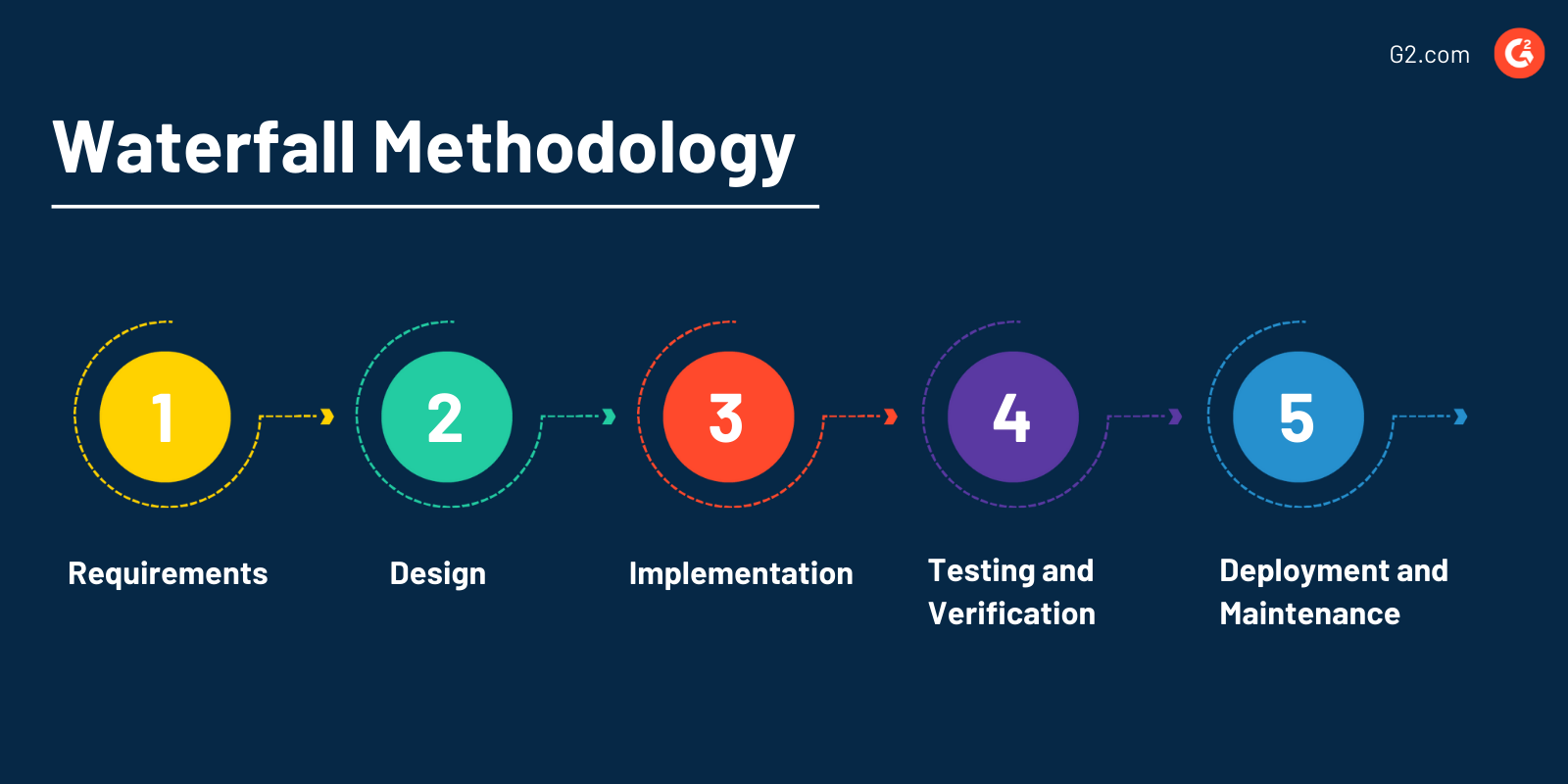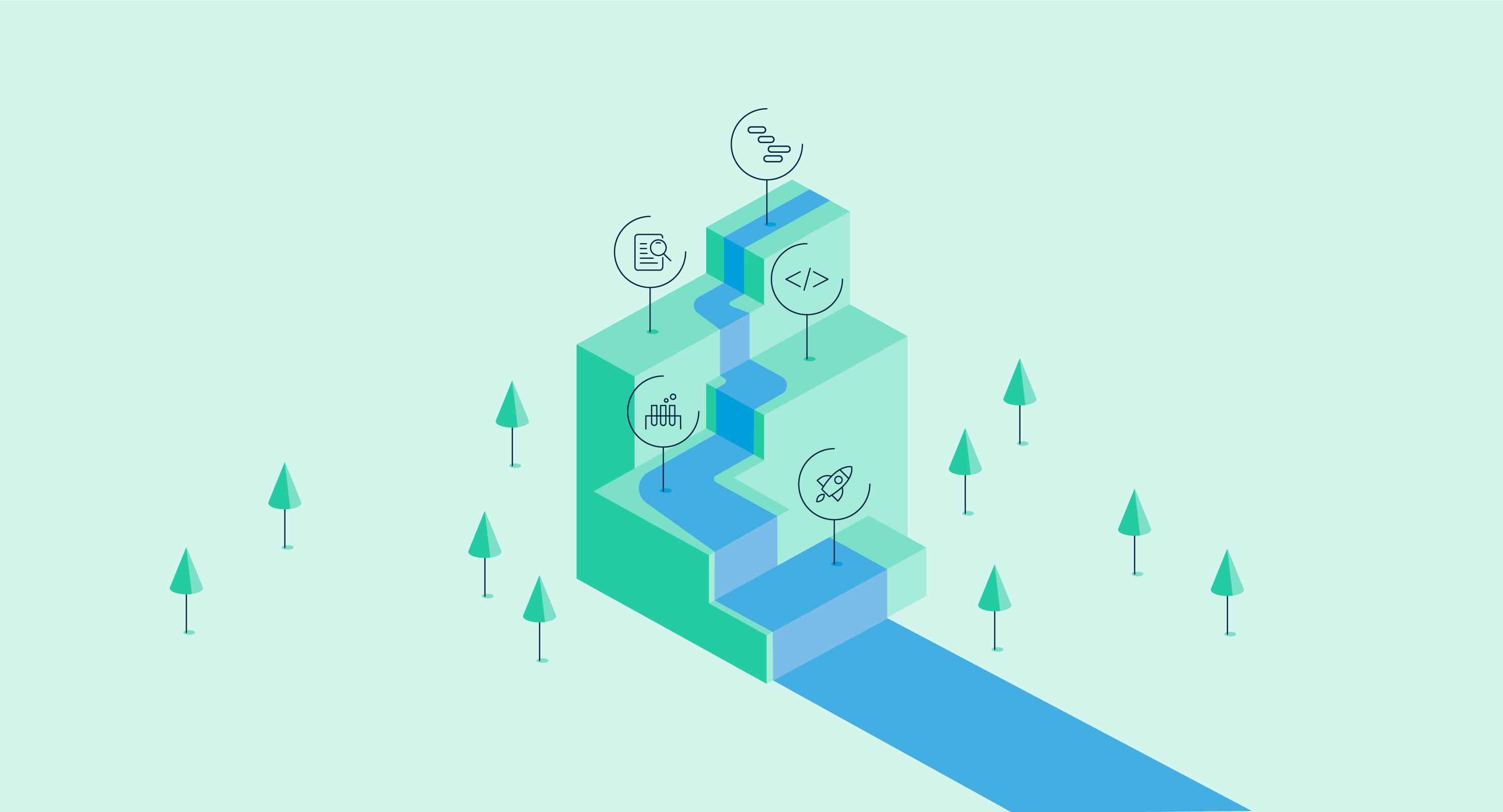When a new idea for a project is presented to your team, one of the first decisions is to determine the project methodology.
There are numerous methods to choose from, and one of them is likely more ideal than others. When you look at the details of an upcoming project, consider the waterfall methodology.
What is waterfall methodology?
The waterfall methodology emphasizes completing tasks sequentially and logically. Tasks are completed in a specific order, and team members don’t return to a previous task after completing what came before.
The waterfall method is a popular technique used in project management software. As employees and managers go about this specific order, they don’t return to a previous phase after it’s completed or move ahead outside of sequential order.
Think of the waterfall process as applying a full face of makeup. The first step is using a primer, followed by a foundation, and then a concealer. Primer is always step one, and you wouldn’t skip to step two before it’s complete.
5 stages of waterfall methodology
When it’s time to tackle a particular project, a project management team often follows these five stages of the waterfall method. Remember, it’s essential to go through these phases in a sequence for successful waterfall project management.

1. Requirements
Like most project models, traditional waterfall methodology begins with clear project requirements. In this stage, potential project requirements, documents, deadlines, and guidelines are analyzed upfront.
It’s up to the project manager to get detailed information, summarized in a written document, including:
- Prices and costs of the materials needed
- Assumptions, risks, and deliverables
- A timeline for completion
- Success metrics and stakeholder expectations
Without these details, a project cannot, and should not, get the green light for the initiative from the customer or key stakeholders. Once everything is collected, the team is assembled, and the project kickoff meeting commences.
2. Design
In the design phase, the project team creates a design specification document (DSD) to record the logistics of the required programming languages, hardware, data layers, and more. This phase also includes designing everything from scenarios to layouts and data models.
This phase is broken down into two parts:
- Logical design: This part of the process outlines the purpose and the scope of the project.
- Physical design: This part develops the hardware and software technologies necessary to get things off the ground.
3. Implementation
After the design phase, the team moves on to the implementation phase. This is often the shortest step in the project, but that doesn't make it less important. Programmers or software developers code various applications during the development process based on the project requirements, specifications, and designs.
Some elements of the implementation stage include:
- Assigning various tasks to team members and developers
- Monitoring and tracking the progress to ensure the project is progressing on schedule
- Adequately managing the workload and resources needed
- Updating the customer, client, or stakeholders as needed
4. Testing and verification
The next step in the waterfall approach is testing and verifying the project details. Team members start with a quality assurance testing strategy and report any issues or bugs. They also check that all product requirements are met. When testing is complete, the team verifies whether the result meets or exceeds the client's or customer's standards.
Test cases are created using the design documents, presented personas, and the project manager’s use case scenarios. Once all the details are tested and verified, the product plan moves forward within the waterfall method.
Other elements in this phase include:
- Creating a template of the project your team could use in the future for similar projects or initiatives
- Closing out any remaining paperwork and getting everything filed
- Celebrating a job completed (and well done!) with the team
5. Deployment and maintenance
The final phase of the waterfall methodology is deployment and maintenance. The project is deployed and maintained when it’s complete and officially released to the customer or client. If any defects or bugs are found over time, or a change or update is requested, a development team familiar with the final product is assigned to take care of the updates to resolve customer issues and ensure customer satisfaction.
Changes to the final product occur when:
- Mistakes were made during the design stage
- Improper requirements were determined
- Changes to the user requirements
Want to learn more about Project Management Software? Explore Project Management products.
Waterfall methodology vs. agile methodology
Teams are often unsure whether the waterfall methodology or agile methodology is the right approach for a specific project.
The waterfall methodology involves upfront planning, where each phase must be completed before the next one begins. The agile project method is more flexible, and every step in the process tackles each task in shorter, repeated cycles. Additionally, the waterfall method has milestones that need to be hit before completing the next phase, whereas an agile project works in sprints where tasks are completed in short windows of time.
.png)
The waterfall method is ideal for projects with specific documentation, fixed requirements, plenty of resources, and an established timeline. It’s also best for projects with a clear picture of a final product and when clients don’t expect major changes to the project's scope once it's underway.
An agile model is best suited for projects where teams work in sprints and scrums and the speed is valued over comprehensive details. An agile approach to project management requires skilled, independent workers and the ability for clients to change the project plan and requirements along the way.
Advantages of waterfall methodology
There are many advantages to this type of workflow. When done right, the waterfall model leads to a long list of benefits.
- Upfront documentation paired with planning stages makes it easy for large teams to stay informed as they approach a shared goal. Can also be a part of program management.
- This method is simple to understand, follow, and arrange tasks.
- Since design is early in the process, it’s easy to make changes before the project advances. This also prevents developers from writing incorrect code during the implementation stage.
- Milestones, project cost, timelines, and deadlines are clearly defined to avoid confusion, making it simple to track progress.
- When a project has a high turnover, a new team member can quickly begin project onboarding with a clear outline of what is needed. This makes it easy for them to step in and contribute without derailing the timeline.
- Clients or customers are provided with the requirements before starting the project. Production is often delayed when customers are not appropriately updated and are constantly adding new requirements.
Disadvantages of waterfall methodology
A waterfall development methodology for projects comes with some disadvantages that need to be considered before implementation.
- Not an ideal method for complex or ongoing projects
- Projects tend to take longer when a chronological approach is used instead of an iterative one (like agile)
- Delays testing until the end of the development cycle.
- Doesn’t have the potential to get user or client feedback halfway through the process, so changes don’t occur until the end
- Clients are often not looped in during the design and implementation stages
- If a design or code has a flaw, the entire process needs to start over
- If one stage in the waterfall methodology is delayed, all others are delayed, too
Don’t go chasing waterfalls
Unless the waterfall in question is this project management style! The waterfall model is a disciplined approach to project management that requires you to adhere to strict deadlines to achieve a high-quality result. You should feel comfortable using this method for any projects with linear instead of fluid steps that need to be carried out in tandem.
Now that you’ve mastered the waterfall model learn more about the 80/20 rule, also known as the Pareto Principle.

Mara Calvello
Mara Calvello is a Content and Communications Manager at G2. She received her Bachelor of Arts degree from Elmhurst College (now Elmhurst University). Mara writes customer marketing content, while also focusing on social media and communications for G2. She previously wrote content to support our G2 Tea newsletter, as well as categories on artificial intelligence, natural language understanding (NLU), AI code generation, synthetic data, and more. In her spare time, she's out exploring with her rescue dog Zeke or enjoying a good book.
